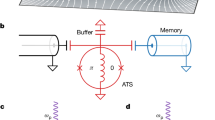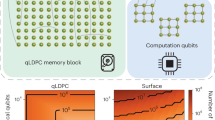Abstract
Random quantum circuits, in which an array of qubits is subjected to a series of randomly chosen unitary operations, have provided key insights into the dynamics of many-body quantum entanglement. Recent work has shown that interleaving the unitary operations with single-qubit measurements can drive a transition between high- and low-entanglement phases. Here we study a class of symmetric random quantum circuits with two competing types of measurement in addition to unitary dynamics. We find a rich phase diagram involving robust symmetry-protected topological, trivial and volume law entangled phases, where the transitions are hidden to expectation values of any operator and are only apparent by averaging the entanglement entropy over quantum trajectories. In the absence of unitary dynamics, we find a purely measurement-induced critical point, which maps exactly to two copies of a classical two-dimensional percolation problem. Numerical simulations indicate that this transition is a tricritical point that splits into two critical lines in the presence of arbitrarily sparse unitary dynamics with an intervening volume law entangled phase. Our results show that measurements alone are sufficient to induce criticality and logarithmic entanglement scaling, and arbitrarily sparse unitary dynamics can be sufficient to stabilize volume law entangled phases in the presence of rapid, yet competing, measurements.
This is a preview of subscription content, access via your institution
Access options
Access Nature and 54 other Nature Portfolio journals
Get Nature+, our best-value online-access subscription
$29.99 / 30 days
cancel any time
Subscribe to this journal
Receive 12 print issues and online access
$209.00 per year
only $17.42 per issue
Buy this article
- Purchase on Springer Link
- Instant access to full article PDF
Prices may be subject to local taxes which are calculated during checkout




Similar content being viewed by others
Data availability
The data plotted in the figures of this Article that support the findings of this study are available via Zenodo at https://doi.org/10.5281/zenodo.4031884.
Code availability
The source codes used to run the simulations of the symmetric random quantum circuit studied in this Article are available via Zenodo at https://doi.org/10.5281/zenodo.4031884.
References
Skinner, B., Ruhman, J. & Nahum, A. Measurement-induced phase transitions in the dynamics of entanglement. Phys. Rev. X 9, 031009 (2019).
Li, Y., Chen, X. & Fisher, M. P. A. Quantum Zeno effect and the many-body entanglement transition. Phys. Rev. B 98, 205136 (2018).
Chan, A., Nandkishore, R. M., Pretko, M. & Smith, G. Unitary-projective entanglement dynamics. Phys. Rev. B 99, 224307 (2019).
Li, Y., Chen, X. & Fisher, M. P. A. Measurement-driven entanglement transition in hybrid quantum circuits. Phys. Rev. B 100, 134306 (2019).
Gullans, M. J. & Huse, D. A. Dynamical purification phase transition induced by quantum measurements. Phys. Rev. X 10, 041020 (2020).
Gullans, M. J. & Huse, D. A. Scalable probes of measurement-induced criticality. Phys. Rev. Lett. 125, 070606 (2020).
Vasseur, R., Potter, A. C., You, Y.-Z. & Ludwig, A. W. W. Entanglement transitions from holographic random tensor networks. Phys. Rev. B 100, 134203 (2019).
Choi, S., Bao, Y., Qi, X.-L. & Altman, E. Quantum error correction in scrambling dynamics and measurement-induced phase transition. Phys. Rev. Lett. 125, 030505 (2020).
Szyniszewski, M., Romito, A. & Schomerus, H. Entanglement transition from variable-strength weak measurements. Phys. Rev. B 100, 064204 (2019).
Tang, Q. & Zhu, W. Measurement-induced phase transition: a case study in the nonintegrable model by density-matrix renormalization group calculations. Phys. Rev. Res. 2, 013022 (2020).
Jian, C.-M., You, Y.-Z., Vasseur, R. & Ludwig, A. W. W. Measurement-induced criticality in random quantum circuits. Phys. Rev. B 101, 104302 (2020).
Cao, X., Tilloy, A. & De Luca, A. Entanglement in a fermion chain under continuous monitoring. SciPost Phys. 7, 24 (2019).
Lopez-Piqueres, J., Ware, B. & Vasseur, R. Mean-field entanglement transitions in random tree tensor networks. Phys. Rev. B 102, 064202 (2020).
Bao, Y., Choi, S. & Altman, E. Theory of the phase transition in random unitary circuits with measurements. Phys. Rev. B 101, 104301 (2020).
Piroli, L., Sünderhauf, C. & Qi, X.-L. A random unitary circuit model for black hole evaporation. J. High Energy Phys. 2020, 63 (2020).
Zabalo, A. et al. Critical properties of the measurement-induced transition in random quantum circuits. Phys. Rev. B 101, 060301 (2020).
Rossini, D. & Vicari, E. Measurement-induced dynamics of many-body systems at quantum criticality. Phys. Rev. B 102, 035119 (2020).
Fan, R., Vijay, S., Vishwanath, A. & You, Y.-Z. Self-organized error correction in random unitary circuits with measurement. Preprint at https://arxiv.org/abs/2002.12385 (2020).
Nahum, A. & Skinner, B. Entanglement and dynamics of diffusion-annihilation processes with Majorana defects. Phys. Rev. Res. 2, 023288 (2020).
Hastings, M. B. Topological order at nonzero temperature. Phys. Rev. Lett. 107, 210501 (2011).
Chen, X., Gu, Z.-C., Liu, Z.-X. & Wen, X.-G. Symmetry protected topological orders and the group cohomology of their symmetry group. Phys. Rev. B 87, 155114 (2013).
Raussendorf, R. & Briegel, H. J. A one-way quantum computer. Phys. Rev. Lett. 86, 5188 (2001).
Zeng, B., Chen, X., Zhou, D.-L. & Wen, X.-G. Quantum Information Meets Quantum Matter (Springer, 2019); https://doi.org/10.1007/978-1-4939-9084-9
Son, W. et al. Quantum phase transition between cluster and antiferromagnetic states. Europhys. Lett. 95, 50001 (2011).
Santos, L. H. Rokhsar-Kivelson models of bosonic symmetry-protected topological states. Phys. Rev. B 91, 155150 (2015).
Tsui, L., Huang, Y.-T., Jiang, H.-C. & Lee, D.-H. The phase transitions between Zn × Zn bosonic topological phases in 1 + 1D, and a constraint on the central charge for the critical points between bosonic symmetry protected topological phases. Nucl. Phys. B 919, 470–503 (2017).
Zeng, B. & Wen, X.-G. Gapped quantum liquids and topological order, stochastic local transformations and emergence of unitarity. Phys. Rev. B 91, 125121 (2015).
Zeng, B. & Zhou, D.-L. Topological and error-correcting properties for symmetry-protected topological order. Europhys. Lett. 113, 56001 (2016).
Fromholz, P., Magnifico, G., Vitale, V., Mendes-Santos, T. & Dalmonte, M. Entanglement topological invariants for one-dimensional topological superconductors. Phys. Rev. B 101, 085136 (2020).
Calabrese, P. & Cardy, J. Entanglement entropy and conformal field theory. J. Phys. A 42, 504005 (2009).
Li, Y., Chen, X., Ludwig, A. W. W. & Fisher, M. P. A. Conformal invariance and quantum non-locality in hybrid quantum circuits. Preprint at https://arxiv.org/abs/2003.12721 (2020).
Gottesman, D. The Heisenberg representation of quantum computers. In Proc. 22nd International Colloquium on Group Theoretical Methods in Physics (eds Corney, S. P. et al.) 32–43 (International, 1998); https://arxiv.org/abs/quant-ph/9807006
Nielsen, M. A. & Chuang, I. Quantum Computation and Quantum Information (Cambridge Univ. Press, 2002).
Nahum, A., Ruhman, J., Vijay, S. & Haah, J. Quantum entanglement growth under random unitary dynamics. Phys. Rev. X 7, 031016 (2017).
Acknowledgements
We thank M. Hafezi, H. Dehghani and A. Nahum for helpful comments, and M. Gullans and D. Huse for suggesting the modified ancilla order parameter and for discussions regarding its saturation value in the topological phase. We acknowledge the University of Maryland supercomputing resources (http://hpcc.umd.edu) made available for conducting the research reported in this paper. A.L. and M.B. are supported by NSF CAREER (grant number DMR- 1753240), the Alfred P. Sloan Research Fellowship and JQI-PFC-UMD. Y.A. is supported by National Science Foundation grant number NSF DMR1555135 and JQI-NSF-PFC.
Author information
Authors and Affiliations
Contributions
All authors contributed equally to this work.
Corresponding author
Ethics declarations
Competing interests
The authors declare no competing interests.
Additional information
Peer review information Nature Physics thanks Xiao Chen, Masaki Oshikawa and Brayden Ware for their contribution to the peer review of this work.
Publisher’s note Springer Nature remains neutral with regard to jurisdictional claims in published maps and institutional affiliations.
Supplementary information
Supplementary Information
Supplementary Sections 1–11 and Figs. 1–11.
Rights and permissions
About this article
Cite this article
Lavasani, A., Alavirad, Y. & Barkeshli, M. Measurement-induced topological entanglement transitions in symmetric random quantum circuits. Nat. Phys. 17, 342–347 (2021). https://doi.org/10.1038/s41567-020-01112-z
Received:
Accepted:
Published:
Issue Date:
DOI: https://doi.org/10.1038/s41567-020-01112-z
This article is cited by
-
General properties of the spectral form factor in open quantum systems
Frontiers of Physics (2024)
-
Measurement-induced entanglement phase transition on a superconducting quantum processor with mid-circuit readout
Nature Physics (2023)
-
Quantum hardware measures up to the challenge
Nature Physics (2023)
-
The hardness of random quantum circuits
Nature Physics (2023)
-
Neural-network decoders for measurement induced phase transitions
Nature Communications (2023)



